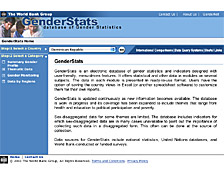This website presents statistics relating to gender issues from more than 200 countries over the last 20 years. Data sources include national statistics, United Nations databases, and surveys conducted or funded by the World Bank. While data is not complete for all countries included over this period, the site does provide a solid statistical foundation to the issues of gender and development at a global level since 1980.
The data is arranged according to a two-step process. The user first selects a country and then selects data categories. There are four main categories: “Summary Gender Profile,” “Thematic Data,” “Gender Monitoring,” and “Data by Regions.” Within these categories are further subsets such as “education” or “opportunity.” Some aspects of the site are still under construction.
For those unfamiliar with statistical analysis, the site provides an extremely useful “about data“ function. This explains possibly unfamiliar terms such as “GNP per capita” or concepts that might have a precise statistical meaning, such as “Labor Force.” It also explains how those who gathered the material interpret more abstract terms such as “Empowerment,” which they define as “voice and decision-making power at the household, community, and national levels.”
The site also includes a useful links section. This page provides access to an extended range of statistical sources. There are links to sites operated by the World Bank as well as to external sites including UN organizations such as UNICEF and WHO. The useful links provide not only statistical information but practical guides to the compilation of statistics, though several of these links are currently broken.
While clearly designed primarily for users with development agency background or those conducting sociological research, this is a useful resource for historians of world history in the late 20th century in a number of ways. It serves to concretize change over time in the relative position of men and women in society; it can be used for regional comparison given that the same statistics are included for all countries; and it can be used to chart government intervention in gender issues. Students of world history might be encouraged to discuss the differences between short-term political change and the slower social changes that can be charted through gender-sensitive demographic data. The site covers a sufficiently long period that the degree to which a change in government or political system (such as the end of communism in Eastern European countries or the demise of apartheid in South Africa) brings changes in gender demographics can be fruitfully discussed.
While the site is particularly useful for those seeking concrete numerical data about gender and development, it also has uses for teachers of world history interested in the production of knowledge. Students might be pressed to think about how data is collected and interpreted, and what implications this might have for the funding of particular health and welfare initiatives related to gender.
Some of the data categories are relatively unambiguous, such as the basic demographic statistics that record birth, death, and life expectancy rates. Even then, however, students might consider what factors could influence the collection of statistics. In this regard, the site would need to be used in conjunction with external resources charting the context in which these demographic changes occurred.
Yet the site is also useful on its own terms in opening up a discussion of these questions by means of the “about data” function. It can serve as an avenue to facilitate learners’ discussion about the collection and interpretation of statistics on gender issues. If some categories of data seem unambiguous at first glance, others are overtly subjective and abstract. Students might examine concepts such as “empowerment” and ask whether it is most usefully measured in the manner the site chooses—by statistics that chart the numbers of women in local, national, and ministerial government. Teachers might use different sets of data to discuss whether they are culturally appropriate in particular national circumstances and whether they allow comparison across national boundaries to be usefully made.



